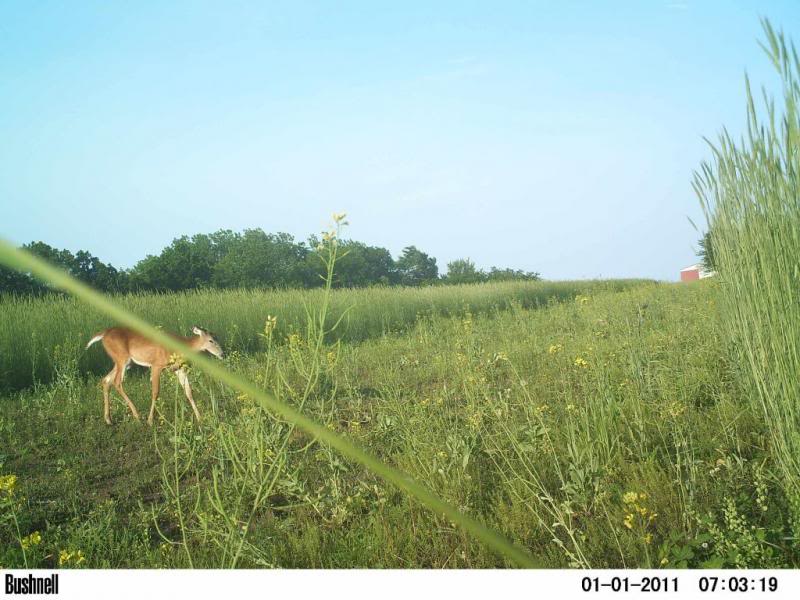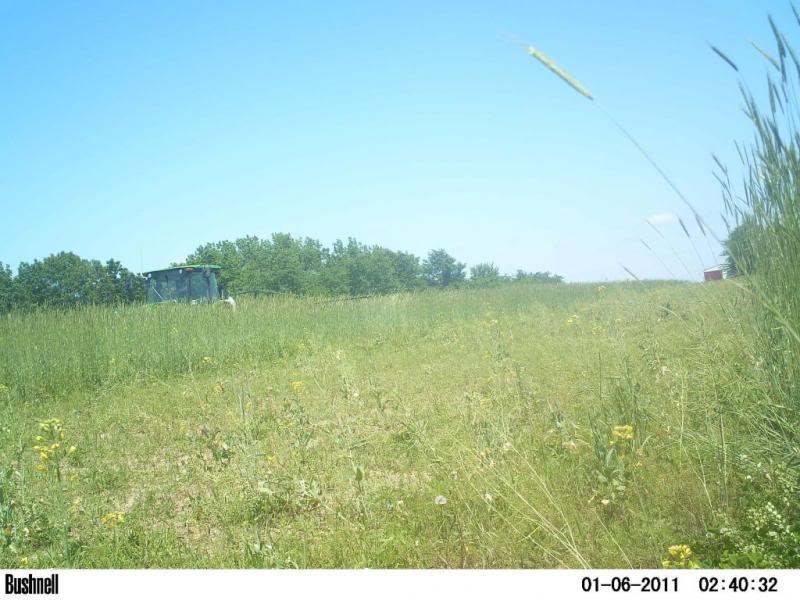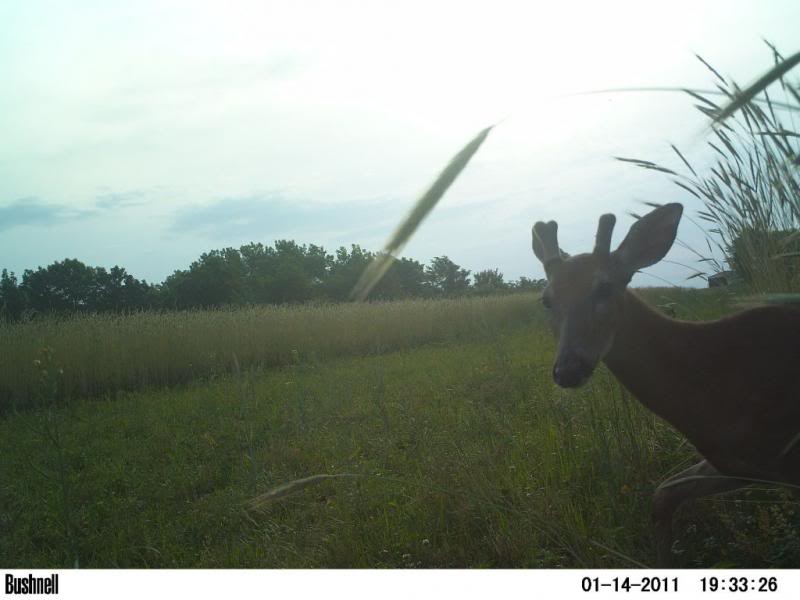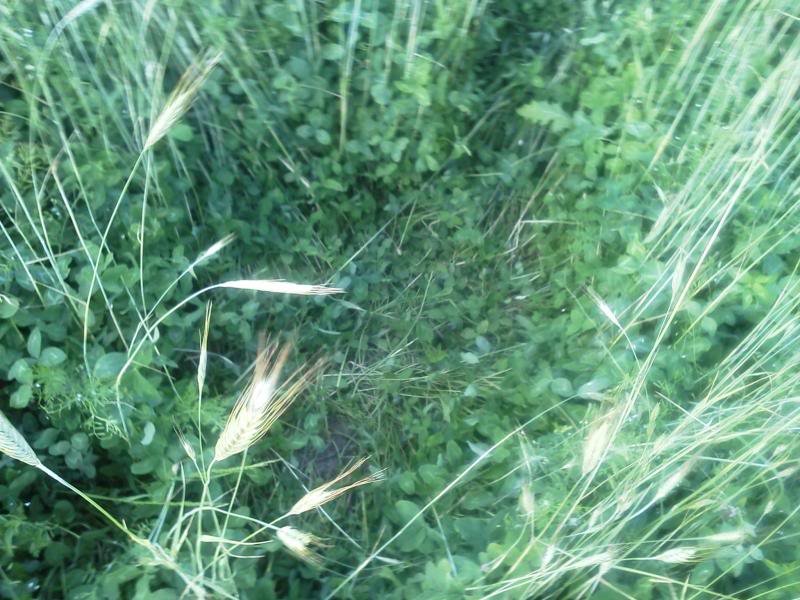dbltree
Super Moderator
July 2nd, 2013
The winter rye has done it's job both as a cover crop and for fawning habitat and sprayed with clethodim and a small dose of gly in early June, it is dry and easily shredded with almost any mower. In our case a batwing Frontier makes short work of it but even a Swisher type will work once killed and dried down.

The shredded straw adds to the surface biomass but it is the 400 miles of rye root systems that help increase soil organic matter as well as hold moisture and subsoil nutrients

Having been sprayed with clethodim and glyphosate, the clovers (planted with the rye last fall) are thriving

In this case both white and red clovers are keeping deer fed and fixing nitrogen for the ensuing crop of brassicas

For those that prefer not to spray, keep in mind that once rye reaches full height, it's easily and permanently flattened by simply running a cultipacker or lawn roller over it.
Once fertility levels are brought up, it is possible...using the rye/brassica rotation shown below...to avoid using synthetic fertilizers and herbicides and still grow beautiful, lush crops that will be full of whitetails. The following are cover crop videos that show how farmers are using the same cover crops we use to feed deer...to increase yields, build soil organic matter, avoid drought losses and lower fertilizer inputs...
http://www.youtube.com/watch?v=PG6ChTWFGJ4
http://www.youtube.com/watch?v=ggIWqmj8Jw4
http://www.youtube.com/watch?v=x7t7sPY4QNA
http://www.youtube.com/watch?v=3loMymwL8TE
http://www.youtube.com/watch?v=nWXCLVCJWTU
http://www.youtube.com/watch?v=VoWlONmJNPc
http://www.youtube.com/watch?v=VBTWny9k05A
http://www.youtube.com/watch?v=2QqegC9L24E
http://www.youtube.com/watch?v=P1_dTqIV3lA
http://www.youtube.com/watch?v=mc1o7r_7GGQ
http://www.youtube.com/watch?v=Blxe7S41q9s
The following is what we plant and in a perpetual rotation that insures we have food in each plot year around. Fertilizer needs will vary depending on soil tests and seeding rates may vary depending on soils and deer densities so our list is merely a starting point to work with....
The winter rye has done it's job both as a cover crop and for fawning habitat and sprayed with clethodim and a small dose of gly in early June, it is dry and easily shredded with almost any mower. In our case a batwing Frontier makes short work of it but even a Swisher type will work once killed and dried down.

The shredded straw adds to the surface biomass but it is the 400 miles of rye root systems that help increase soil organic matter as well as hold moisture and subsoil nutrients

Having been sprayed with clethodim and glyphosate, the clovers (planted with the rye last fall) are thriving

In this case both white and red clovers are keeping deer fed and fixing nitrogen for the ensuing crop of brassicas

For those that prefer not to spray, keep in mind that once rye reaches full height, it's easily and permanently flattened by simply running a cultipacker or lawn roller over it.
Once fertility levels are brought up, it is possible...using the rye/brassica rotation shown below...to avoid using synthetic fertilizers and herbicides and still grow beautiful, lush crops that will be full of whitetails. The following are cover crop videos that show how farmers are using the same cover crops we use to feed deer...to increase yields, build soil organic matter, avoid drought losses and lower fertilizer inputs...
http://www.youtube.com/watch?v=PG6ChTWFGJ4
http://www.youtube.com/watch?v=ggIWqmj8Jw4
http://www.youtube.com/watch?v=x7t7sPY4QNA
http://www.youtube.com/watch?v=3loMymwL8TE
http://www.youtube.com/watch?v=nWXCLVCJWTU
http://www.youtube.com/watch?v=VoWlONmJNPc
http://www.youtube.com/watch?v=VBTWny9k05A
http://www.youtube.com/watch?v=2QqegC9L24E
http://www.youtube.com/watch?v=P1_dTqIV3lA
http://www.youtube.com/watch?v=mc1o7r_7GGQ
http://www.youtube.com/watch?v=Blxe7S41q9s
The following is what we plant and in a perpetual rotation that insures we have food in each plot year around. Fertilizer needs will vary depending on soil tests and seeding rates may vary depending on soils and deer densities so our list is merely a starting point to work with....
Plant ALL in one plot in strips or blocks
Alice, Kopu II, Durana (or comparable) white clover 10% of plot, sow at 6#'s per acre with the rye combination in the fall or in the spring with oats and berseem clover. Correct Ph and P&K with soil tests
Brassicas in 45% of plot
Purple Top Turnips 3#
Dwarf Essex Rape 2#
GroundHog Forage radish 5#
Plant in mid to late July in most Midwest states, or 60-90 days before your first killing frost, Use 200#'s of 46-0-0 urea and 400#'s of 6-28-28 per acre. Follow the dead brassicas with oats and berseem or crimson clover in mid spring at 60#'s oats and 12-15#'s berseem clover and/or crimson and/or 50#'s of chickling vetch)
Cereal Grain combo in 45% of plot...we use 50# each rye, oats and peas along with radish and clover seed all planted in half of each feeding area
Winter rye 50-80#'s per acre (56#'s = a bushel)
Spring oats 50-120#'s per acre (32#'s = a bushel)
Frostmaster Winter Peas or 4010/6040 Forage peas 20-80#'s per acre
Red Clover 8-12#'s per acre or white clover at 6#'s per acre (or 20-40 pounds hairy vetch and 20-30#'s crimson clover on sandy soils)
Groundhog Forage Radish 5#'s per acre
Plant in late August to early September, if following well fertilized brassicas use 100 - 200#'s of urea, if starting a new plot add 400#'s of 6-28-28 but for best results soil test and add only what is necessary.
Rotate the brassicas and rye combo each year















